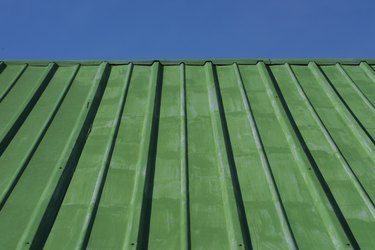
Once reserved for covering sheds and outbuildings, metal roofing in attractive standing-seam designs is making an appearance on higher-end homes, especially in regions with heavy snowfall. Attics are notorious for collecting warm, moist air that can damage the roof structure if it has no way to escape. The attic structure beneath a metal roof is just as susceptible to moisture damage as is the structure beneath a shingled roof. On a shingled roof, homeowners may choose from a variety of vents, but with a metal roof, some types of vents are better than others are.
Inadequate Venting
Video of the Day
Metal roofs do not stop moist, warm air from rising through the house and into the attic. Some high-quality, metal roofing types reduce heat transference from the outside of the metal roof, which can become very hot on a sunny day. However, a metal roof cannot eliminate high humidity levels. Lower-quality metal roofing may add to the problem. Heat and humidity in the attic can warp rafters and roof sheathing. Roof trusses can expand and contract, resulting in truss uplift.
Video of the Day
Static Vents
Static vents with no moving parts perform as effectively on a metal roof as they do on a shingled roof. However, static venting usually requires numerous, low-profile vents installed in a line near the roof's ridge. These vents rely upon the natural action of hot air rising and cooler air flowing into the attic from soffit vents, which are installed below the eaves. The downside to numerous static vents is that each time you cut into a metal roof, the risk of leaks increases. Metal roofing specialists should install all types of vents in metal roofs minimizing leaks.
Turbine Vent
Turbine vents feature whirligig-type fans that spin when even a mild breeze blows. The spinning action creates a suction that pulls hot moist air out of the attic. Like static vents, a turbine vent must pair with soffit vents, but one turbine vent can quickly exhaust stale, attic air, resulting in only one entry into the metal roof.
Roof Ridge Vents
The safest way of venting a metal roof is installing a roof ridge vent. A roof ridge vent is static, but doesn't require cutting into the metal roof's middle. Instead, the roofers do not install the regular metal roofing over the top of the ridge, but leave a gap that runs the ridge's entire length. A vented ridge cap, covered with metal matching the roof, is installed along the ridges' entire length, allowing hot attic air to escape. Roof ridge vents are attractive and effective.
Gable Vents
Gable vents are not roof vents at all, but serve the same function without the need of cutting into the metal roofing. If the roof has numerous gables, gable venting may suffice. Two gable vents may not be sufficient. Gable vents require soffit vents that encourage air circulation. Check with local building codes to ensure that your metal roof is adequately vented.